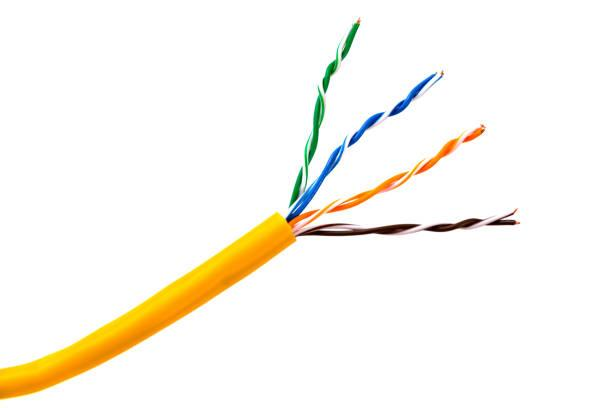What is LAN Cable and Types of LAN Cable | FS Community
A LAN cable is used almost everywhere on this planet. It plugs into ethernet ports on various network devices to help create home or business networks to share files, information, and data between each other and establish internet connections. This blog will give you a comprehensive guide to help you understand more about a LAN cable.
Mục Lục
What Is LAN and LAN Cable?
LAN stands for Local Area Network. A LAN is a private network consisting of routers, cables, access points, switches, and other units that let devices link to web servers, internal servers, and other LANs using Wide Area Networks (WAN). The most straightforward technique you can use to set up a LAN is by using an ethernet cable.
So, what is a LAN cable? It is a networking cable that connects different devices. For example, if you have a printer that connects to your router with a cable, that cable is a LAN cable. A LAN cable helps in the connection of computers and hardware to form a LAN and is best for usage in small distances.
Is LAN cable the same as Ethernet cable?
No, it is not. An Ethernet cable is basically another type of LAN cable. Explained below are the types of LAN cables.
Types of LAN cable
There are three main types of LAN cables:
-
coaxial cable
-
copper twisted pair
-
fiber optic cable
Each of the above three LAN cables has different designs and functions, which power your network connections. Get a thorough description and illustration of all these three LAN cables by reading this great article: Fiber Optic Cable vs Twisted Pair Cable vs Coaxial Cable.
You will most likely be using coaxial cables for connection from your Internet Service Provider to your modems. The coaxial cable powers that connection, which provides your network with internet access. Many people use coaxial cables because their shielded design lets the center conductor quickly transmit data while being protected from damage and interruptions.

Copper twisted pair is the ordinary networking cable used to connect computers, routers, switches, and IP cameras. Two insulated copper wires are twisted around one another to minimize crosstalk or electromagnetic induction between pairs of wires. For specific business locations, the networking cable is enclosed inside a shield that works as ground. This is referred to as Shielded Twisted Pair (STP). The ordinary wire to your home is unshielded Twisted Pair (UTP).
The twisted-pair Ethernet cable comes in different categories including:
-
Cat5e cable
-
Cat6 cable
-
Cat6a cable
-
Cat7 cable
-
Cat8 cable

Fiber optic cables are faster and more efficient at transmitting network signals. Think about the speed of light, and you will understand how they operate. These cables are faster, more reliable, and carry larger bandwidth than the copper wire can handle. Fiber optic cables enable end-to-end connections, where you don’t share signals with other users on the network. This limits internet speed slowdowns during peak usage hours. Feel free to check out the Fiber Optic Cable Types: Single Mode vs Multimode Fiber Cable.

Fiber optic cables usually have different connector types, some of which range from:
-
SC to LC
-
SC to SC
-
ST to LC
-
ST to SC
How to Choose a LAN Cable?
Always choose a LAN cable with the performance and range you need. What will you need to consider before choosing?
-
Start by checking the speed of your home/office network. If your internet runs at 1Gbps, an old LAN cable is a pitfall. If you have a slow internet connection lying between 10 to 20 megabits per second, you can use a Cat 5 cable or a newer model. Cat means “Category.” The following number after Cat represents a specification version supported by the cable.
-
Establish your desirable transmission speeds. Longer LAN cables have slower transmission speeds than short ones. The 100-meter rating only works for large professional projects.
-
Opt for robust LAN cables. Today, most routers are faster, more capable, and facilitate faster network speeds. This is why you need to choose robust LAN cables, which can promote faster network speeds and future-proof your network setup.
Is LAN cable faster than Wi-Fi?
Yes, a plugged-in LAN cable is faster than Wi-Fi. Even though Wi-Fi speeds today have significantly increased, courtesy of standards like 802.11ac and 802.11n, which provide maximum speeds of 866.7Mb/s and 150 Mb/s, respectively, the use of Ethernet through a LAN cable to access the internet is still better and faster than Wi-Fi.
Alternatively, a LAN cable can provide up to 10Gb/s if you have a Cat 6 cable. The exact maximum speed of your LAN cable depends on the type of LAN cable you are using. But still, even the commonly used Cat 5e cable supports up to 1 Gb/s. Unlike Wi-Fi, this LAN cable speed is consistent.

The primary determinant of your internet activities should be based on the internet speeds offered by your ISP. HOWEVER, a LAN cable is unique as it will affect the speed between devices on your network. For instance, if you want to transfer files faster between two computers in your house, a LAN cable is faster than Wi-Fi. Since your internet connection type is not involved in transferring files, it is upon the maximum speeds that your local network hardware can provide.
Conclusion
All in all, a LAN cable is used to connect your networking devices via wireless routers or other network switches. So, choose the best LAN cable type that can meet your needs and provide value for your hard-earned money.















![Toni Kroos là ai? [ sự thật về tiểu sử đầy đủ Toni Kroos ]](https://evbn.org/wp-content/uploads/New-Project-6635-1671934592.jpg)


